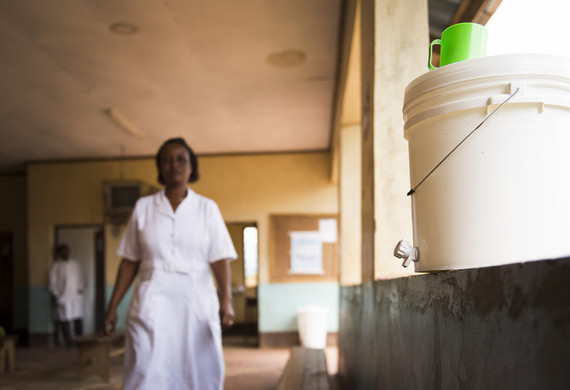
Registered Nurse Esther Mongi walk past a container of drinking water at the Mlali Health Centre. A recent WaterAid project to build a water storage tank at the center, now provides it with a supply of clean water. Mlali Health Centre, Mlali Village, Mvomero District, Morogoro, Tanzania – August 2014. Photo: WaterAid / Eliza Deacon
Imagine you are nine months pregnant, at home, and suddenly feel the first pangs of labor. Your mind starts to race. If you are in the United States, you likely have a plan: you call a loved one and start making your way to the hospital, or you might call your doula or midwife and stay put at home. You are excited, nervous, anxious — counting the minutes between contractions and the hours until you meet your little one for the first time.
Of all the things on your mind, wondering whether you will have disinfected surfaces and hands, a toilet and emergency services if things take a turn for the worst isn’t one of them. Neither is how you are going to collect water to bring to your delivery. Instead, you rest assured knowing that your delivery will likely be safe, your baby healthy, your body able to rest and heal.
For women in the world’s most economically deprived countries, collecting water is a key part of preparing to give birth — if they are lucky enough to have a source of water that they can use. In South and Southeast Asia and sub-Saharan Africa, more than 70 percent of the poorest women give birth at home. And, believe it or not, those that do have a better shot at having water nearby than women who give birth in a health facility.

A recent WHO survey of health facilities in 64 low- and middle-income countries found that more than one-third do not have an improved water source — one that protects water from contamination, especially fecal contamination — or soap for handwashing and other hygiene needs. Of those that do have a water source, the majority don’t have water that is truly safe to drink, a reliable supply or even water on the premises themselves. In fact, the WHO survey counted a facility as having access even if the water source was 500 meters away. That’s the equivalent of five American football fields, a distance too great for most people to carry a 40 pound jerry can of water; it’s painful to imagine a woman in labor doing so, and yet many have no other option.
For mothers and their newborns, this can be a matter of life and death. Last year, I had the opportunity to work with WaterAid‘s Papua New Guinea team to establish a new partnership with a maternal and child health clinic called Susu Mamas (the name means “mother’s milk”). We knew that having water, sanitation and hygiene (WASH) in a health clinic often serves as an incentive for women to attend. Sure enough, the lines for the clean flush toilet inside the buzzing clinic were long, all day.

Patients wait to be seen by Health Centre staff at the Mlali Health Centre, Mlali Village, Mvomero District, Morogoro, Tanzania — August 2014. Photo: WaterAid / Eliza Deacon
But for the many women who didn’t give birth in the Susu Mamas clinic, those who gave birth in other clinics or in homes that don’t have WASH, the impacts of delivery in an environment without safe drinking water, sanitation or hygiene could be enormous. The Susu Mamas staff summed it up in just one word: sepsis.
Sepsis is a potentially fatal outcome of infection, responsible for 16 percent of deaths of newborns less than one month old and 11 percent of maternal deaths worldwide. These deaths are especially tragic because sepsis is so easily prevented when you have a clean birthing environment, clean instruments and hands and water and soap at the ready. It is just one example of the life threatening results of pregnancy, delivery, and the first 1000 days of life without the benefit of the basic services that we too often take for granted.
That’s why WaterAid, as part of our new Healthy Start Campaign, is joining the International Day for Maternal Health and Rights by calling on the world’s governments to commit to providing water, sanitation and hygiene in health care facilities.
We believe that no new health care facility should be built without WASH, and that existing ones must have water, sanitation and hygiene facilities added in. We believe that hygiene promotion should be a part of health care workers’ mandates, and that all households should have the water and soap they need to wash their hands, dishes and all the other things we all desire to keep clean. Last but not least, we believe that no woman should ever have to give birth in an environment that doesn’t have a toilet, safe drinking water and soap on the premises.
Now is our chance to say enough is enough. Please join us in calling on the US government to prioritize WASH in households, communities and health care facilities. No pregnant woman should have to haul her own water to her delivery or take her chances on an infection that may kill her. No baby should be born into conditions that risk her life before she’s even opened her eyes. And no government should stand by while this is still happening. It’s time for us to take a stand, in solidarity with mothers everywhere.
